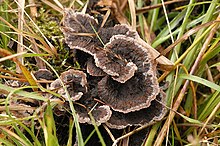Thelephora terrestris
| Thelephora terrestris | |
|---|---|

| |
| Scientific classification | |
| Kingdom: | Fungi |
| Division: | |
| Class: | |
| Order: | |
| Family: | |
| Genus: | |
| Species: | T. terrestris
|
| Binomial name | |
| Thelephora terrestris Ehrh. (1787)
| |
Thelephora terrestris, commonly known as the common fiber vase[1] or earthfan fungus[2] is an inedible species of fungus in the Basidiomycota phylum.[3]
History and taxonomy
This fungus was first described by Jakob Friedrich Ehrhart in 1787.[4][5]
Habitat and ecology
Throughout North America[1] and Europe[5] Thelephora terrestris can be found in soil. It is commonly found in sandy soils under pine trees, on roots[1] and twigs.[6]
This
It is a dominant mycorrhizal fungus,[9] re-establishes quickly after disturbances such as forest fire, and is considered stress tolerant.[11]
Outside of the Pinus genus, it is also capable of forming mycorrizha with other trees such as alder, birch, oak, beech, and poplar.[2]
Thelephora terrestris virus 1 (TtV1), which is a mycovirus, can infect this fungi.[2]
Description
Thelephora terrestris is present year round, though is mostly seen July to December.
| Thelephora terrestris mycorrhizal | |
|---|---|
| Edibility is inedible | |
The
The edibility of fungus is unknown, but it is considered too tough to be worthwhile.[13]
Thelephora palmata is a similar species which is comparatively stinky and less widely distributed.[13][14]
Physiology
The full life cycle can be reproduced and studied in a laboratory, both ectomycorrhizal form and mushroom form.[15]
Due to the mycotoxins that the fungi produces, it protects pinus trees from root pathogen Phytophthora cinnamomi.[9]
References
- ^ ISBN 0-394-51992-2.
- ^ PMID 26700067.
- PMID 15744104.
- ^ "Mycobank: Thelephora terrestris". Mycobank. Retrieved 2021-02-19.
- ^ JSTOR 2989992.
- ^ ISBN 0-412-36970-2.
- ^ .
- PMID 27547573.
- ^ .
- S2CID 21922463.
- .
- .
- ^ OCLC 797915861.
- ISBN 978-0-88192-935-5.
- doi:10.1139/b81-267.
